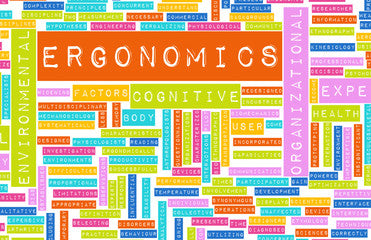
In case you didn’t know, there’s more to office ergonomics than just chairs! There’s so much information on the internet these days related to office ergonomics, so we thought we could do a little mythbusting of our own. But first, let’s look at what Ergonomics is.
Ergonomics is a science that helps align products to users and jobs to workers. The word ergonomics comes from a combination of two Greek words: ergon, which means “work,” and nomos, which means “natural laws.” Sometimes ergonomics can be referred to as human engineering, biotechnology, or human factors.
Not only does ergonomics cover items that improve working conditions, it also includes how the products you use in your daily life are designed. But ergonomics can refer not only to the way objects are designed, but also the way they are arranged for optimum use.
Here are some common myths about ergonomics, along with the facts:
- Myth: Ergonomics aren’t important in the office. A lot of early ergonomics research was directed toward industrial professions. For example, the risks of musculoskeletal disorders for someone who operates a jackhammer may be high, that doesn’t negate the risk for office workers; however, risks to office workers wasn’t immediately recognized. In more recent years, experts have learned that ergonomic products are important in all types of workplaces.
- Myth: An ergonomic chair will solve all your problems. Again, this isn’t true. Sitting in an ergonomic office chair can help prevent some, but not all, musculoskeletal disorders. Additionally, there’s no one-size-fits-all type of ergonomic chair—different solutions work best for different people.
- Myth: Repetitive motion is the most common ergonomic injury. While overuse absolutely can contribute to musculoskeletal problems, it’s just as likely that sitting with poor posture for hours—leaning, hunching, and slouching—will lead to injury. These positions put stress on our bodies over time.
- Myth: Ergonomics only focuses on preventing injuries. A large part of ergonomics does focus on preventing injuries; however, that’s not the only reason for ergonomics. Ergonomics also focuses on worker comfort as well as optimizing human performance. In other words, ergonomics helps improve working conditions on the job and at home.
- Myth: Ergonomics are only for at work. Ergonomic products are everywhere. The handles of your kitchen knives, the height of your bathroom counter, the grip of a screwdriver, and the firmness of your mattress were all designed with ergonomics in mind. Special populations such as the elderly may have additional ergonomic needs, including items like grab bars in the bathtub, or easy-to-use door handles.
- Myth: Ergonomic products are too expensive for small businesses. It’s easy to look at ergonomics as an expense rather than an investment. But think about it this way: many people choose a car for its safety features, believing those features are worth the cost of protecting themselves and their families. Businesses who purchase ergonomic products for their employees demonstrate their commitment to their health and well-being. More and more organizations are beginning to realize the importance of helping their people prevent injuries that can be more costly down the line, when weighed against the costs for sick time, short- or long-term disability, and insurance premiums.

